An 8-Day Tour of the Amalfi Coast
by Adriana ruiz
Set off on an 8-day adventure across the Amalfi Coast, including excursions to Sorrento, Capri, Pompeii and Herculaneum.
Day 1-2: Positano
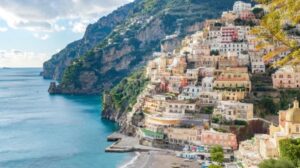
Positano is a visually stunning village on Italy’s Amalfi Coast, characterized by its vibrant cascade of cliffside houses and tranquil beaches. Its labyrinthine streets lead to historical sites such as Grotto La Porta, which evidences its Upper Paleolithic origins and later Roman influence. The culturally rich architecture, including the Church of Santa Maria Assunta with its Byzantine Black Madonna, reflects the diverse influences over the centuries. Once a medieval port, Positano is now a haven for artists.
Activities to do:
– Explore the town: Wander through the charming streets and visit the boutique shops.
– Beach time: Relax on the famous Spiaggia Grande or the more secluded Fornillo Beach.
– Boat tour: Consider a boat tour to admire the coast from the water.
Day 3: Amalfi and Ravello
Amalfi
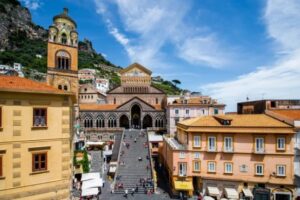
A Historical Coastal Town Amalfi, nestled at the mouth of a deep ravine and surrounded by dramatic cliffs, is a town that boasts a rich maritime history. It was once the capital of the maritime republic known as the Duchy of Amalfi, an influential trading power in the Mediterranean from 839 to around 1200. The town’s historical significance is further highlighted by its inclusion in the UNESCO World Heritage Sites.
Activities to do:
– Visit the Amalfi Cathedral and explore the town’s main square.
Ravello
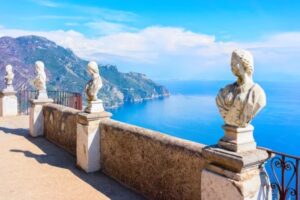
The Elevated Escape Perched high above the Amalfi Coast, Ravello offers breathtaking views and a serene escape from the coastal buzz. Founded in the 5th century as a haven from barbarian invasions, Ravello was an important town of the maritime Republic of Amalfi during the 9th century.
Activities to do:
– Enjoy the stunning gardens of Villa Rufolo and Villa Cimbrone, and take in the panoramic views.
– Visit historical structures, including the Ravello Cathedral and the various palazzi of the mercantile nobility.
Ravello Cathedral (Duomo di Ravello): This is the central religious structure of Ravello, which features the “Pulpit of the Gospels,” created in 1272 by Nicolò di Bartolomeo from Foggia.
Palazzi of the Mercantile Nobility: Ravello was home to many palaces of the mercantile nobility, including the Rufolo, d’Aflitto, Confalone, and Della Marra families. These palazzi are a testament to the town’s rich history as a trading power in the Mediterranean.
– Ravello, known as the ‘City of Music,’ hosts the prestigious Ravello Festival, one of Italy’s most renowned symphonic music festivals. The festival typically runs from July 2nd to August 30th. However, as of now, the specific details for the Ravello Festival in 2024 have not been published. It features a wide range of performances, including symphonic concerts, chamber music, and recitals by international artists. The main stage is set at the Belvedere of Villa Rufolo, offering breathtaking views that enhance the musical experience. The festival pays homage to the composer Richard Wagner and has a tradition of focusing on his works, among others. Additionally, the festival celebrates various forms of performing and visual arts, making it a highlight of the summer cultural calendar on the Amalfi Coast. For the most up-to-date schedule and events, it’s best to check the official Ravello Festival website or local event listings.
Day 4: Sorrento
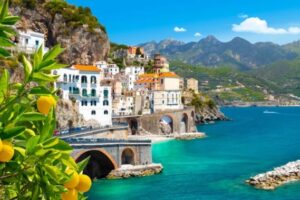
Sorrento, a town with a rich history dating back to the 8th century BC, is perched on cliffs overlooking the Bay of Naples. Once an important trade hub for the Etruscans and later a luxurious Roman resort, it also played a significant role in the maritime activities of the Duchy of Amalfi. Today, Sorrento is a vibrant destination known for its stunning views, artisanal shops, and the production of Limoncello.
Activities to do:
– Stroll around Piazza Tasso and enjoy the local shops and cafes.
– Explore the ancient ruins. Here are some of the notable ancient sites:
Villa di Pollio Felice: A hidden gem, the remains of a villa that dates back almost two millennia. Visitors can stroll down a Roman road to reach this site.
Villa Limona: Another ancient ruin, less documented in historical records, yet an integral part of Sorrento’s historical landscape.
– Limoncello tasting: Sorrento is famous for its limoncello, so don’t miss out on a tasting session.
Day 5: Capri
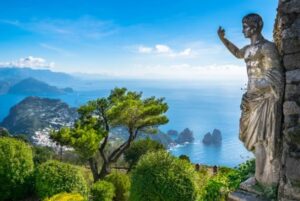
Capri is an island that seamlessly blends its rich Neolithic and Greek heritage with Roman imperial grandeur, evident in historical sites like Villa Jovis. Today, it’s a luxurious sanctuary with natural wonders such as the Blue Grotto, chic boutiques, and historical gardens. Whether strolling through Capri town, relaxing in Anacapri, or exploring ancient ruins, visitors are treated to an exquisite mix of history, culture, and natural beauty, making Capri an unforgettable Italian experience.
Activities to do:
– Take a ferry to the island of Capri and visit the Blue Grotto. The Blue Grotto, or Grotta Azzurra, is a sea cave on Capri’s coast, famous for its vivid blue waters created by sunlight filtering through an underwater cavity. It is visited in small rowboats, steered by expert oarsmen through the grotto’s narrow entrance, often accompanied by the echoes of Neapolitan melodies.
– Explore the ancient ruins.
Villa Jovis: Also known as the Villa of Jupiter, this is a Roman palace built by Emperor Tiberius and completed in 27 CE. It’s the largest of the twelve Tiberian villas on Capri mentioned by Tacitus. The villa’s complex spans several terraces and covers about 7,000 square meters. The ruins provide insight into 1st-century Roman architecture and the life of Tiberius on Capri.
Villa Damecuta: Located in Anacapri, Villa Damecuta is one of the best-preserved Tiberian villas. It’s part of a trip that includes other villas built by Emperor Tiberius, offering a historical journey through the emperor’s residences scattered across the island.
– Visit the Gardens of Augustus (Giardini di Augusto). These panoramic gardens are a true spectacle of nature, featuring terraces adorned with colorful blooms that create a vibrant and visually stunning environment. The gardens offer captivating views of the island’s landscapes and coastline, including the iconic Faraglioni rocks and the Bay of Marina Piccola.
– Visit Monte Solaro, the highest point of Capri, which reaches an elevation of 589 meters (1,932 feet) above sea level. It is a popular destination for visitors due to its panoramic views of the island and the Bay of Naples. You can access the summit by a chairlift from Anacapri or by following a hiking trail if you’re up for a more adventurous route. The top of Monte Solaro offers breathtaking 360-degree views and is a must-visit for anyone traveling to Capri, encapsulating the essence of the island’s majestic beauty.
Day 6: Path of the Gods Hike
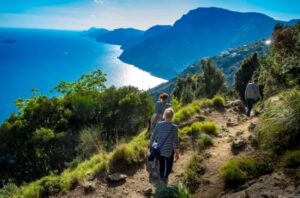
The Path of the Gods (Sentiero degli Dei) is an enchanting trail offering spectacular views of the Amalfi Coast, connecting the towns of Positano and Praiano. Its name, Sentiero degli Dei, hints at its divine connection, believed to be the route taken by gods to help Ulysses against the sirens. The path is rich in history, having been walked by shepherds, farmers, and artists, drawn by its beauty and the panoramic views it offers.
The hike itself is a journey through diverse landscapes, from forests to cliffs, with the Tyrrhenian Sea and Sorrento Peninsula stretching out below. It’s a moderate 7 km trek at 630m elevation, passing olive groves and vineyards, and offering views of Capri’s Faraglioni and Positano’s vibrant colors. Starting in Bomerano and ending in Nocelle, it takes 1.5 to 3 hours to complete, with an option to extend the hike to Positano, immersing travelers further in the coastal experience.
Day 7: Pompeii or Herculaneum
Spend a day exploring the ancient ruins of Pompeii or Herculaneum.
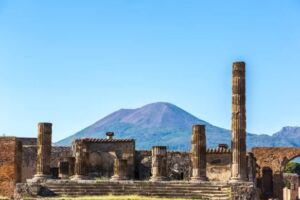
Pompeii: Pompeii is a legendary archaeological site nestled in the shadow of Mount Vesuvius, near the modern city of Naples, Italy. It was once a thriving Roman city, rich in culture and bustling with life. The city’s history dates back to the 8th century BC, when it was founded by the Oscans. Pompeii became a significant commercial hub, attracting Greeks, Etruscans, and eventually falling under Roman influence in the 2nd century BC.
The city reached its peak during the Roman period, boasting elegant houses, elaborate villas, and a vibrant public life with temples, baths, theatres, and a 20,000-seat arena. Its prosperity was derived from the fertile volcanic soil, which supported the cultivation of olives, grapes, and other crops, making Pompeii a center for trade and commerce.
However, Pompeii’s fortune took a tragic turn on August 24, 79 AD, when Mount Vesuvius erupted, burying the city under a thick layer of volcanic ash. The eruption was catastrophic, but it paradoxically preserved the city in time, offering an unparalleled window into ancient Roman life. Excavations have revealed a city frozen in the moment of destruction, with streets, buildings, and even the casts of victims poignantly on display.
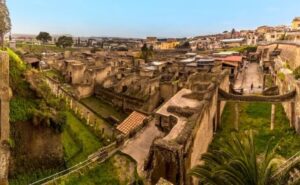
Herculaneum: Herculaneum, often overshadowed by its more famous neighbor Pompeii, is another remarkable site that suffered a similar fate during the Vesuvius eruption. Located closer to the volcano, Herculaneum was a smaller, wealthier town, known for its luxurious seaside villas and artistic life.
The town’s origins are shrouded in myth, with legends suggesting it was founded by Hercules himself. Historically, it was likely established by the Oscans or Etruscans in the 7th century BC and later became a Roman municipium. Herculaneum was a popular resort for Rome’s elite, thanks to its coastal location and mild climate.
During the Vesuvius eruption, Herculaneum was buried under a deep layer of ash and mud, which solidified and preserved the city’s structures, including two-story homes with intact architecture and décor. Unlike Pompeii, the pyroclastic material that covered Herculaneum carbonized and preserved organic materials like wood, providing an even more intimate glimpse into the daily lives of its inhabitants.
Day 8: Leisure and Departure
Relax: Enjoy your last day at leisure, revisiting your favorite spots or discovering new ones.
Departure: Prepare for your journey home.
Other activities to do in the Amalfi Coast:
– Take a Boat Tour: A great way to see the Amalfi Coast’s dramatic coastline.
– Spend Time on the Beach. Here are some of the most beautiful beaches where you can relax and soak up the Mediterranean sun:
Marina Grande, Positano: This beach is the epitome of Amalfi Coast glam, often frequented by celebrities. It’s one of the largest beaches, about 300 meters long, and offers a lively atmosphere with plenty of services.
Arienzo Beach, Positano: Known for its clear waters and pebbled shore, Arienzo Beach is accessible by a stairway of 300 steps, offering a more secluded spot.
Maiori Beach: This is one of the longest sandy beaches on the Amalfi Coast, ideal for families and those looking for a spacious area to relax.
Erchie Beach: A small, secluded beach surrounded by towering cliffs, providing a tranquil escape.
Gavitella Beach, Praiano: This charming beach catches the sun until late in the evening, making it perfect for sunbathing and enjoying the sunset.
Duoglio and Santa Croce Beaches, Amalfi: These beaches are known for their crystal-clear waters and are great for water sports enthusiasts.
Marina di Vietri, Vietri sul Mare: Offering a more traditional seaside experience, this beach is lined with colorful umbrellas and has a lively local vibe.
– Visit the Smeraldo Grotto: located in Conca dei Marini on the Amalfi Coast. This sea cave is known for the extraordinary emerald hue of its waters, a natural wonder partly inundated by the sea. The grotto owes its name to the sunlight that filters through an underwater fissure, creating a mesmerizing green glow that illuminates the cave. Visitors can access the grotto by land, descending by stairs or an elevator to the cave level, where a boat tour awaits to fully experience the cave’s beauty. The interior of the grotto also houses an underwater nativity scene, adding to its cultural significance.
Read more:
A Guide to Living in Italy with a Dog
Dog Friendly places in and near Rome
A Guide to Events Happening in Spring in Milan, Rome, Florence, and Bologna
20 Places to Explore in Milan – A Local’s Guide
A Weekend Guide to Naples’ Culinary and Cultural Highlights
20 Places to Explore in Milan – A Local’s Guide
The Colossal Statue of Constantine: FREE Exhibition at the Capitoline Museums
15 Must-Visit Museums, Galleries, and Cultural Sites in Italy
Don’t Miss the Chance to Visit the Vatican Museums for Free
A Guide to Visiting the Vatican Museums
Italy’s Most Enchanting Towns Accessible by Train
New Celio Archaeological Park in Rome – Free Admission
Learn about the residence permit for digital nomads from non-EU countries working in Italy
Italy’s Investor Visa: A Visa to Attract Strategic Investments from Abroad
Find and Buy Your Ideal Property in Italy with Our Professional Services
Buying Property in Italy – How to Get a Mortgage as a Foreigner
How to Open a Bank Account in Italy as an Expat
Learn Italian and open up new possibilities for your career and personal growth
Prepare for the CILS B1 Citizenship exam to obtain citizenship by marriage, residence or study or work in Italy.
Switching to a self-employment permit from a study or job-seeking one
FAQs for Italian Citizenship by Marriage (2023)
Understanding the Tessera Sanitaria: Your Italian Health Insurance Card
Non-Married Partners: How to Obtain a Residence Permit in Italy as De Facto Cohabitants
How to get tax identification number for foreign citizens (Codice Fiscale)
How to register in Italy as an EU citizen
Mastering Public Transport in Italy
The Advantages of Dual Citizenship with an Italian Passport: Unlocking Boundless Opportunities
What you need to know about Visas and Permits to stay in Italy
Red flags to identify a scam when renting in Italy





Leave a Comment:
You must be logged in to post a comment.